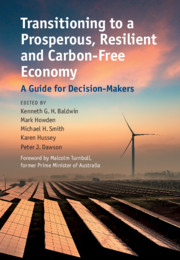Book contents
- Transitioning to a Prosperous, Resilient and Carbon-Free Economy
- Transitioning to a Prosperous, Resilient and Carbon-Free Economy
- Copyright page
- Dedication
- Contents
- Figures
- Tables
- Contributors
- Foreword
- Introduction
- 1 Policy Frameworks and Institutions for Decarbonisation: The Energy Sector as ‘Litmus Test’
- Technologies for Decarbonising the Electricity Sector
- Example Economies
- 9 Decarbonisation Strategies and Economic Opportunities in Australia
- 10 Decarbonisation Strategies and Economic Opportunities in Indonesia
- Cities and Industry
- Land Use, Forests and Agriculture
- Mining, Metals, Oil and Gas
- Addressing Barriers io Change
- Index
- References
10 - Decarbonisation Strategies and Economic Opportunities in Indonesia
from Example Economies
Published online by Cambridge University Press: 08 October 2021
- Transitioning to a Prosperous, Resilient and Carbon-Free Economy
- Transitioning to a Prosperous, Resilient and Carbon-Free Economy
- Copyright page
- Dedication
- Contents
- Figures
- Tables
- Contributors
- Foreword
- Introduction
- 1 Policy Frameworks and Institutions for Decarbonisation: The Energy Sector as ‘Litmus Test’
- Technologies for Decarbonising the Electricity Sector
- Example Economies
- 9 Decarbonisation Strategies and Economic Opportunities in Australia
- 10 Decarbonisation Strategies and Economic Opportunities in Indonesia
- Cities and Industry
- Land Use, Forests and Agriculture
- Mining, Metals, Oil and Gas
- Addressing Barriers io Change
- Index
- References
Summary
Indonesia is a major source of greenhouse gas (GHG) emissions but also vulnerable to the effects of climate change. Most emisisons come from land-use change and energy. Indonesia's challenge is to decarbonise its economy while its population increases and its economy expands, with energy demand set to increase by 300% from 2010 levels by 2050. The main strategies are energy efficiency, electrification of energy and deep decarbonisation of the power sector, which is dominated by coal. Indonesia has abundant potential for renewable energy including hydro, solar, wind, geothermal and bioenergy. The Indonesian Government has set a target of 31% renewables by 2050. GHG emissions are estimated to be reduced by 50% by 2050. Transport emissions are to be reduced by investment in low-carbon mass transport, such as trains, and fuel switching to gas, biofuels and renewables. The implications of climate change are not yet fully internalised in Indonesian policy and planning. The investment required is large but manageable – around 1.3% of GDP in 2020, falling to 0.7% of GDP in 2050.
- Type
- Chapter
- Information
- Transitioning to a Prosperous, Resilient and Carbon-Free EconomyA Guide for Decision-Makers, pp. 237 - 268Publisher: Cambridge University PressPrint publication year: 2021



